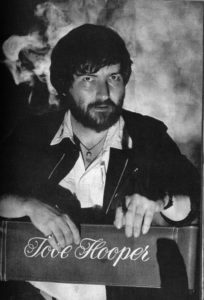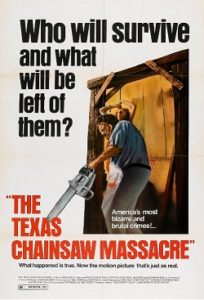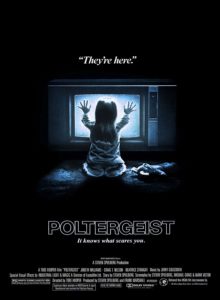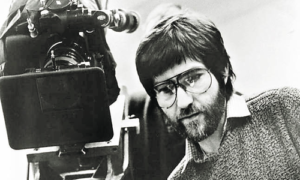 Here we bid farewell to the brilliant, and frustratingly erratic, Tobe Hooper.
Here we bid farewell to the brilliant, and frustratingly erratic, Tobe Hooper.
Nearly all the Hooper obituaries that have appeared thus far give a pretty good indication of what he’s known for, identifying him, invariably, as “the director of THE TEXAS CHAINSAW MASSACRE.” That 1974 no-budgeter was a seminal event in horror history that, unlike many of its early 1970s fellows, still holds up. Of course Hooper went on to make many other films and published one novel over the course of his forty-plus year career, meaning that he may never have succeeded in matching his signature work, but it wasn’t for lack of trying.
Of the many iconic horror moviemakers who emerged from the 1970s, the Texas-born Hooper was the most unassuming. Neither as politically driven as George Romero and John Carpenter nor as zeitgeist-conscious as Wes Craven, Tobe Hooper had an admirably unpretentious credo (expressed in his 2011 novel MIDNIGHT MOVIE): “I offer the world what I offer the world: scary flicks. I’m not trying to make a grand statement or anything. I want to entertain…”
“I offer the world what I offer the world: scary flicks.”
 Obviously a lot—indeed—perhaps too much has been written about THE TEXAS CHAINSAW MASSACRE. There’s really not a whole lot I can add other to second the many superlatives that have been bestowed upon the film, which, as one critic has stated, plays as if it were made by a crazy person—although careful study will reveal that its steadily mounting insanity was achieved by rigorous craftsmanship as skilled as that of a Hitchcock film. Such an accomplishment is one few other filmmakers could hope to pull off, and one that even Hooper himself was hard-pressed to repeat; as it turned out, he never came close to doing so.
Obviously a lot—indeed—perhaps too much has been written about THE TEXAS CHAINSAW MASSACRE. There’s really not a whole lot I can add other to second the many superlatives that have been bestowed upon the film, which, as one critic has stated, plays as if it were made by a crazy person—although careful study will reveal that its steadily mounting insanity was achieved by rigorous craftsmanship as skilled as that of a Hitchcock film. Such an accomplishment is one few other filmmakers could hope to pull off, and one that even Hooper himself was hard-pressed to repeat; as it turned out, he never came close to doing so.
In some ways the Tobe Hooper saga was a sad, even tragic one. Certainly he had a lengthy career that many would envy, and an impressive following among horror buffs the world over, but it’s an unequivocal fact that he was far, far better than most of the material to which he lent his talents.
A major contribution to his problems was simple bad luck, which plagued Hooper throughout his career. That was evident first in CHAINSAW, which made a great deal of money that was hoarded by unscrupulous distributors, and then EATEN ALIVE, a failed attempt at recapturing the elusive magic of the earlier film. THE DARK, from which Hooper was fired after a few days of filming, was even more disastrous.
There followed the first of Hooper’s “comebacks” (it wouldn’t be the last), in the form of the 1979 Stephen King adapted miniseries SALEM’S LOT. Despite some annoyances, it remains Hooper’s finest post-CHAINSAW film, a terrifically shivery piece of work whose scares, like those of CHAINSAW, were achieved through care and ingenuity rather than excess gore or elaborate special effects.
 1981’s THE FUNHOUSE was no big deal, but Hooper’s next movie, the mega-budgeted Steven Spielberg production POLTERGEIST, definitely was. In another manifestation of rotten luck the film, despite being the biggest moneymaker of Hooper’s career, turned out to be extremely damaging to his reputation. To this day rumors persist that Spielberg, either because Hooper did too many drugs or because the former simply wanted to direct it himself, was the movie’s actual helmer. On that subject Hooper himself had this to say (in MIDNIGHT MOVIE): “Ah, POLTERGEIST. Lot of rumors about my involvement with that one, and you’ll hear only rumors because nobody’ll talk about it, myself included.”
1981’s THE FUNHOUSE was no big deal, but Hooper’s next movie, the mega-budgeted Steven Spielberg production POLTERGEIST, definitely was. In another manifestation of rotten luck the film, despite being the biggest moneymaker of Hooper’s career, turned out to be extremely damaging to his reputation. To this day rumors persist that Spielberg, either because Hooper did too many drugs or because the former simply wanted to direct it himself, was the movie’s actual helmer. On that subject Hooper himself had this to say (in MIDNIGHT MOVIE): “Ah, POLTERGEIST. Lot of rumors about my involvement with that one, and you’ll hear only rumors because nobody’ll talk about it, myself included.”
POLTERGIEST was at least followed in 1983 by Hooper’s most satisfying project of the decade: the three minute music video for Billy Idol’s “Dancing with Myself.” A black humored blast of eighties-centric energy containing zombies, killers and some very blatant nods to THE TEXAS CHAINSAW MASSACRE, the video, in the words of a Deep Red reviewer, “has more style, wit and kinetic zap than any of his last three mega-buck Cannon misfires.”
That last point refers to a most unfortunate development in Hooper’s career: his three-picture deal with the notorious Cannon Films, which gave us the ridiculous LIFEFORCE, the sporadically inspired TEXAS CHAINSAW MASSACRE 2 and the dreary INVADERS FROM MARS. As a Starlog article warned, “If INVADERS FROM MARS doesn’t succeed, it could be the final nail in Hooper’s professional coffin. And back to low-budget he may go.”
That is indeed where he went. Hooper was reportedly offered the chance to direct RETURN OF THE LIVING DEAD and POLTERGEIST II, but turned both projects down, with his next feature taking until 1990 to appear. SPONTANEOUS COMBUSTION was touted as another comeback–comedown was a better word, despite it being the most memorable of Hooper’s final ten features, which included the Stephen King adaptation THE MANGLER, the SciFi Channel mainstay CROCODILE, THE TOOLBOX MURDERS and Hooper’s last film DJINN, which appeared in 2013.
There was, thankfully, one bright spot amid all the awfulness: the novel MIDNIGHT MOVIE, written by Hooper and Alan Goldsher, and published by Three Rivers Press in 2011. About the discovery of an early Hooper film that turns out to have horrific properties, it mixes reality and fiction in a most adroit and provocative manner. Told in a wonderfully distinct, hard-bitten voice, MIDNIGHT MOVIE was inspired by the actual restoration of Hooper’s long-lost debut feature EGGSHELLS, and set in the horror fandom milieu in which Hooper spent much of his final years. If you’re a Hooper fan (however casual) and haven’t read this novel you’re urged to remedy that oversight ASAP! 
Hooper claimed to have more novels in the works, and I for one would have liked to have read them. Unfortunately they never appeared, leaving Hooper fans with yet another what-might-have-been to ponder, and a post-mortem scoreboard that reads thusly: one great film and one pretty good one, a fun music video and a terrific novel. Not a bad tally, but it could have been much, much better.
